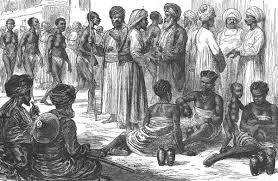THE CREOLES
Learning objectives
After studying the chapter, the student should be able to:
- Assess the achievements of the Creoles in West Africa and explain why Britain changed its attitude and policy towards them late in the nineteenth century.
- Show how, and explain why, Christianity expanded rapidly in West Africa during this period.
- Compare the impact of the Creoles on West Africa with that of the British and French missionaries in Uganda during this period.
Sieara Leone in the 19th and Twentieth Centuries
The early years of Siera Leone: 1807-50
Siera Leone was originally inhabited by the Mende and Teme, before it was taken over by the British as a Crown Colony in 1807. The British decided to make Freetown in the headquarters of its anti- slave trade squadron which patrolled the West African coast. The captured slave ships were brought to Siera Leone and all their cargos of slaves, when freed, became known as “recaptives.” Altogether 40 000 free slaves were settled in Siera Leone. The population had grown rapidly from just 2 000 in 1807 to 11 000 in 1825 and to 40 000 in 1850.
Siera Leone became one of the great cultural “melting pots” of the world since its population was a blend of peoples from different cultures, languages, religions as well as different geographical locations, as in West Africa from Senegal right down to Angola.
Governor Charles McCarthy (1814-1824) settled the “recaptives” in villages of which had a school and a church. He and his successors followed a policy of spreading western education and Christianity among the “recaptives” who embraced these aspects of British culture with zeal. The original Siera Leone black settlers and the “recaptives” were grateful to the British who had liberated them from slavery. They identified themselves with their British rulers, but not in the manner a slave identifies himself with his master. Black Siera Leoneans felt themselves to be free citizens of the British Empire, not a conquered people.
Most of the villages were given English names, like Kent, York and Wellington and two villages’ founded by ex- West Indian soldiers, waterloo and Hastings, recalled British military history, Africa was, however, remembered by Kissy, (named after the Kissy people) Kru and Congo Town. Not all the recaptives were settled in the farming villages some were either recruited into the army, the (Royal African Corps), or apprenticed (adopted) into the homes which educated them and gave them their own surnames.
Who were the Creoles?
The recaptives intermarried with the original black settlers who had come from England and Canada in the late eighteenth century. By 1850 the Creoles had emerged as a distinct group. The creoles were essentially blacks with a slight mixture of white blood, but they developed a culture and way of life that was as much European as it was African. They were Christian and monogamists, but they kept the extended family system as in African societies. Their language, Krio, was the English language africanised. The Creoles maintained ethnic clubs and societies such as those of the descendants of Igbo and Yoruba. Their Christian religion, was like lengthy funerals, and the so called communication with the family dead.
The Creole culture which followed after 1850 was Christian, but with an emphasis upon the events of the life -cycle – (birth, baptism, circumcision, marriage and death) reflecting the influence of Africa religions as well. The Creole social system was built on monogamy like European societies. Creole food was a blend of West Indian French and African cooking. The numerous cultural strands which make up the Creoles are best seen in Krio, language which is English and Yoruba enriched by Portuguese, Spanish and French vocabulary and containing elements of Temme, Mandinka, Igbo, Susu and Arabic.
Early Creole achievements
At first when the recaptives moved from the villages into Freetown, they had built mud huts or houses alongside the elegant houses of the settlers. They were lowly pedlars (small – scale traders), hawkers , tailors, barbers , carpenters or masons , but soon they began trading in the interior , operating respectable shops and buying or building storey houses like the settlers,. By 1839, two “recaptives” were rich enough to purchase auctioned slave ships for their coastal trading operations. The “recaptives” worked hard, lived cheaply, co – operated in wholesale purchases and were soon out selling both European and settler merchants.
Many of the creoles became wealthy and educated their children in secondary schools in Freetown and even in universities in England. As the children of both groups intermarried the distinction between receptive and settlers slowly disappeared. The recaptives were not assimilated by the settlers, instead the Creoles, who emerged as a distinct group by 1850, were a blending of settlers and “recaptives”, the proud inheritors of European, American and numerous African cultures. It must be noted that the Creole achievement was strongly evident in education. In 1868, for instance, 22% of the people in the colony had been educated in schools. The figures of Prussia were 16% and only 13% for England during the same period. The British missionary societies deserved credit for their share in this magnificent effort, but they were never able to supply enough schools and maintain enough teachers to meet the demand. There were secondary schools for both boys and girls and a teacher training college, Fourah Bay, was formed in 1827, cater becoming a university in 1876.
The height of Creole Civilisation: 1850- 1890
The educational system poured forth a stream of teachers, clergymen, doctors, lawyers and writers, producing many of the distinctions of West Africa. John Thorpe was the first African lawyer in 1850, while J.B. Horton became the first medical doctor in 1859. He graduated at the same time with William Davie, and the two were renowned for their pioneering work for a long time.
Samuel Ajayi Crowther became the first African Protestant Bishop in 1864, and he is most remembered for the Niger Mission which was wholly manned by African clergymen. His all- Creole staff in the Niger Mission also partly Christianised the delta city states and created a self – supporting, self – governing Delta church. Other Creole Missionaries were also active among the Igbo and the Yoruba and in the Gambia.
The educated Creoles excelled in spreading the religion of the book. In 1861 the Church of England withdrew its missionaries from Siera Leone and turned the entire work over to the Creoles under the native Pastorate Church.
Sir Samuel Lewis was probably the most outstanding Creole during the 19th century. He became the first newspaper editor its, the first Mayor of Freetown, the first African to be granted Cambridge and Oxford degrees and the first African Knight.
Creoles had always sat in the Governors; Council, but in the 1850’s the growing maturity of the society brought forth agitators for increased representation. In 1863 a new constitution. In 1863 a new constitution introduced executive and legislative councils in which Creoles were represented in both councils. In 1872 when Creoles held almost half of the senior civil service posts, Governor Pope – Hennesy maintained that there were enough qualified Creoles to replace the entire European staff. In 1893 therefore; Freetown was made a municipality with its own mayor. By the end of the century Creoles formed an educated society, proud of their achievements, who voiced their views in a vigorous and flourishing press, and took a prominent part in religious and secular government. Moreover agriculture was an exception to the story of success. The original settlers worked hard growing pepper, cotton and cinnamon on a large scale. The two commodities Europe wanted, sugar and cotton, did not grow well, nor could the settlers really compete in the world market without the use of slave labour. The “recaptives” first turned to farming, but although they understood African agriculture, they could not achieve a respectable standard of living like the settlers; the “recaptives” were ambitious and hence turned from farming to trade. The villages declined as the young people left for Freetown to become shopkeepers or traders. Necessity made the Creoles an adventurous and exploring race. Their traders first spread out into the northern rivers, the interior and the Sherbvo. They purchased condemned slave ships and traded further down the coast. In about 1839 “recaptives” began to return to Egba land in search of both their relatives and work, so that by 1851 there were 3 000 Egba “recaptives” living in Abeoleuta. By the 1880’s creoles were operating businesses in Bathurst , Monrovia, Cape Coast , Accra, Lome , Porto Novo, Lagos , Abeokuta , on the Niger and in the Cameroons.
The Creoles pioneered trade in areas untouched or only slightly touched by European traders. They opened up the Siera Leone hinterland land and developed a flourishing trade in groundnuts in the north and palm oil in the south. Many Yoruba “recaptives” returned to Yoruba land and Lagos. A blend bourgeoisie arose, living in expensively built mansions in Freetown, Lagos and Bathurst. Each mansion generally contained a marble burst of Queen Victoria – a symbol of Creole wealth and power, and identification with Britain.
Perhaps the most successful Creole traders were Richard Blaize (1854-1904), who left Freetown in 1862 and made his fortune in Lagos. Of Yoruba origin, Blaize started as a retailer mainly in imported cloth, but he expanded his trade to become a wholesaler who imported directly from England, and as an exporter of palm oil, palm kernels and cotton. He started a credit bank and also a newspaper, The Lagos Times. In 1896, Blaize’s various enterprises were worth £150 000- well over £ 1 million by today’s values.
Communities sent appeals to Siera Leone for missionaries and teachers to be sent to them.
In many instances some Europeans were sent, but it was the Creole teachers and missionaries far more than the Europeans, who, in responding to these appeals, were the pioneers of education and Christianity along the coast as well as in some parts of the interior of West Africa. As already noted, Bishop Crowther led an all Creole staff which christianised the city states and created a self supporting and self -governing Delta Church before the end of the century. In this way, Creoles were pioneers among the Igbo and Yoruba. More notable is the fact that in 1875 the Lagos Anglican churches were organized into a pastorate on The Siera Leone model, almost totally operated by Creole clergy men. Even as late as 1900. Creoles clergy favoured the majority of the missionaries among the Yoruba. Everywhere Creole held the prominent church positioning an Anglican Bishop (Crowther), Superintendants in Anglican and Methodist churches, a Colonial Chaplain in the Gambia, and archdeacons on the Niger. They filled most of the civil service posts even at higher levels, in Siera Leone. Many posts in the Gambia, the Gold Coast and Lagos were filled by the Creoles, at least until the deliberate de- Africanisation policy of the late19thcentury was implemented by post – partition Governors.
Initially, as the British expanded their empire into West Africa, they were dependent upon the Creoles to fill the junior and many other senior posts of the civil service. In this way the Creoles were regarded as equal partners in the development and administration of the West African a region. Creoles sat in the executive and legislative council of Ghana, Gambia and Nigeria.
In Ghana, Creoles were: judges of the Supreme Court, colonial treasurer, Solicitor – General, Postmaster general, chief Medical officer, district officers and one acting governor. In Nigeria Creoles occupied posts of the registrar of the Supreme Court, Colonial Treasurer and Postmaster General. In the Gambia two successive Chief Justices, and in Abeokuta, both the president and secretary – General of the Egba United Board of Management were Creoles. In Liberia one Creole was elected mayor of Monrovia and another, President of the Republic. Under the Royal Niger Company and in Lagos as well as in Dalear, Creoles held responsible positions as marine engineers. Moreover, in Fernando Po, a Creole prospered as a cocoa plantation owner. Everywhere along the coast creoles were either the first or among the first as clergymen, lawyers, doctors and newspaper owners. In fact, as late as 1925, 44 out of 56 barristers were of Creole descent. The foregoing facts and figures demonstrate beyond any doubt that created and the wheels of civilization and modernization in West Africa, in all spheres of economic, political, social and colonial government administration. Due to the vast advancement achieved by the Creoles in West Africa Sierra Leone thus became the hub of the region the nerve centre in all aspects of development. Freetown newspapers were read all along the coast, more copies being sold outside than inside Sierra Leone. The wealthy charities built schools, churches and public buildings which gave Freetown the appearance of comfort and wealth. Freetown was the centre, and the Creoles the agents of a unique fusion of European and African culture which inspired other Africans to imitate them. Thus Siera Leone became the motherland of Christianity Western education, and culture and the spread of English language in British West Africa.
Although the major Creole group was Christian, there were Muslims as well. Muhammed Shitta Bey, born in Waterloo, of Yoruba “recaptives” was typical, except in his religious conviction, of hundreds of other Creole sons abroad. As a child he emigrated to Badagri with his parents. As a man he traded on the Niger from his business headquarters in Lagos, when he made his money. He did not forget Freetown, but gave generously towards the rebuilding of the Fourah Bay mosque in 1892. In Lagos he spent £4 000 on building a mosque which still bears his name. He was one of the earliest advocates of Western education for Muslims. In recognition of his good works, the Sultan of Turkey awarded him a dectorate and the title “Bey”.
Freetown was also an intellectual centre in the 19th century. Sierra Leone’s “sons abroad” sent their children back to Freetown for their secondary education. Creole children, along with the children of the rising African educated class, along the coast, still returned to Freetown for teacher – training, divinity and university degrees. As a result the largest proportion of the student body of Florah bay College was drawn from outside Siera Leone. This shows how vitally central Siera Leone had become, to the civilization of West Africa. Furthermore, Creole culture was creative. In linguistics J.C Taylors’s work on the Igbo, C. Paules on Niger and P.J. Williams on Igbirra are less well known than Bishop Crowthers Grammar and vocabulary of the Yoruba Language in 1843. In Medical research, Dr J.B Horton wrote a number of books on tropical medical medicine, the most important of which was The Medical Topography of the West Coast of Africa, which was published in 1860. Dr J.F Easmon, head of the Ghana Medical Service, researched on blackwater fever and Dr Oguntola Sapara studied the Sopono smallpox society of Lagos. In history and Geography of Siera Leone J.B.Horton wrote his West African countries and peoples, Samuel Johnson, “ Holly John-son” son of a pioneer Creole missionary , completed his classic History of the Yoruba in 1897.Between 1850 and 1898 the Creoles were called Siera Leoneans by Africans who lived along the coast , although a very small community excelled in every field of endeavors’ open to them , (trade, religion, the professions, administration and the creative arts), Freetown, in the last fifty years of the 19th Century, shone with a brilliance and held an importance that was well out of proportion to its small size. These were the golden years, the age of Creole civilization.
Examintion Tpye Questions
- Assess the achievements of the Creoles in West Africa and explain why Britain changed its attitude and policy towards them late in the nineteenth century.
- What did the Creoles contribute towards the civilisation of West Africa during this period? Why did the British change from a policy of assimilation to indirect rule between 1890 and 1914?
- With reference to West Africa show how, and explain why, Christian missions and missionaries were a force for modernizationand change.
- Assess the achievements of the Creoles in West Africa and explain why Britain changed its attitude and policy towards them late in the nineteenth century.
- Show how, and explain why, Christianity expanded rapidly in West Africa during this period.
- Compare the impact of the Creoles on West Africa with that of the British and French missionaries in Uganda during this period.



